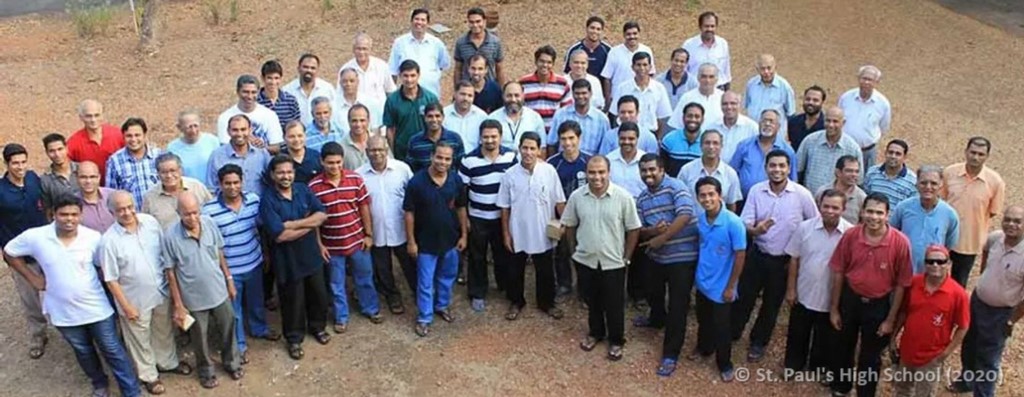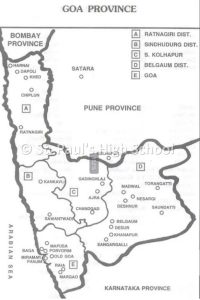
History of Jesuits in Goa

St. Francis Xavier was the first Jesuit to come to Goa; King John III of Portugal, whose naval forces had acquired certain areas of India in particular Goa (1510), was keen on promoting Christianity in them. St. Francis Xavier on a ship Santiago set sails for Goa on 7th April 1541, Xavier’s 35th birthday, but due to bad weather it was marooned in Mozambique. The Governor-Elect Martim Afonso de Sousa, who was travelling in the same ship, was in a hurry to reach Goa, so he proceeded in a smaller ship, taking Xavier along. So it was Xavier alone, the first Jesuit, who landed in Goa on 6th May 1542.
On his arrival in Goa Xavier found a Church well established. He came to know that the Holy Mass had been celebrated for the first time on the Goan soil on 25 November 1510, He also learnt that Goa had been constituted into a Diocese by Pope Clement VII already in 1533 with its jurisdiction extending from the Cape of Good Hope (South Africa) to China and Japan.
Soon after his arrival in Goa, he was invited to head St. Paul’s College, a pioneer seminary for the education of diocesan priests, which became the first Jesuit headquarters in Asia. Gradually, more Jesuits arrived from Europe via Portugal so much so that by 1549 St. Ignatius found it fitting to constitute the Jesuit Province of GOA (sometimes called Province of India) with Xavier as the first Provincial. It became the first Jesuit Province outside Europe and the third in the Society after Portugal and Spain. Its territory covered the entire area from the Southern tip of Africa until Japan in the East.
The number of Jesuits coming to India increased rather rapidly. In 1561 there were in this Province 148 members, with 79 at St Paul’s College (22 priests, 29 Scholastics and 28 Brothers) and the rest dispersed in 12 missions including Goa. Most of the Jesuit missionaries ran schools, as means of evangelization, both in Goa itself and in other stations of the Province. In Goa, they had St. Paul’s College where in 1556 the first printing press with movable types of Roman script was set up, and a school in Margao (1574) which was later shifted to Rachol (present Seminary).
It was only on 5th January 1560 that Fr. Pero Mascarenhas and Bro. Manuel Gomes crossed the Zuari River and celebrated the first Mass in Cortalim. In 1585 the Jesuits built a residence, unique in the Society and the only one outside Europe, where Professed Fathers lived under strict rules of poverty. It was called the Casa Professa. The building that we see today is but a part of that edifice which was partly destroyed by fire in 1663. In 1594 foundation was laid of the adjoining church of Bom Jesus (Good Jesus), which was completed and consecrated on 15 May 1605.
This magnificent church, bearing many architectural similarities to the Church of Gesù in Rome, which is sometimes referred to as the ‘Mother Church’ of the Jesuits, was raised to the rank of Minor Basilica by Pope Pius XII in 1948.
UNDERSTANDING THE JESUITS IN GOA… A Book available at the Goa Provincial’s Office
Written by veteran Jesuit, Gregory Naik SJ
Abstract below written by Frederick Noronha

They have been called the “schoolmasters of Europe”. For decades, if not centuries, this religious order has played a key role in exchanging information, about science and plants, between India and Europe. At times, they were conservatives, and at other times, they have been almost radical. The Jesuits – or Society of Jesus – has also played a crucial, though sometimes challenged, role in Goa as well.
So, it is not surprising to see a book titled ‘Jesuits of the Goa Province: A Historical Overview (1542-2000)’ emerge on the stands. It may have not got the attention it deserves. The book is authored by the veteran Jesuit, Gregory Naik SJ, and has been published by Cinnamon Teal.
Naik served the Jesuit Headquarters in Rome, the Jesuit Educational Association for South Asia in New Delhi, and was also the SJ (or Society of Jesus) provincial in Goa itself. Since 2009, he established the Goa Jesuit Archives, and has been working on it since.
The Jesuit link with Goa has been rather strong. The order landed here in 1542. That is very early in the history of the Society, which was officially founded only in 1540 itself, or two years earlier. The Jesuits have played a role in shaping Goa’s history, though today they run only a handful of schools like Britto in Mapusa and Loyola in Margao, and not a single college in their Goa Jesuit Province (which extends, actually, beyond the borders of Goa). More on that later…
Depending on how you see it, this can be quite an interesting book. You may or may not be a fan of the Jesuits, but this book is packed with colourful information and useful facts. Even if these pages are a Jesuit product, it makes for an interesting read nonetheless.
How did the Jesuits land in Goa? What was Goa like in the 1540s? How did the Jesuit Province of Goa (sometimes also called the Province of India) come about in 1549? Is it true that this was the first Jesuit province outside of Europe, and only the third after Portugal and Spain? Or that its area spread from the southern tip of Africa to Japan in the east? Read and find out…
The Jesuit story is rich and complex, at times it is also bizarre and unbelievable. The geographical spread of the Society – from their base in Goa – is just one part of the story. Their achievements in various fields is another part of the story.
Recently, while working on the early linguistic influences on India, I was surprised to realise the extent of the role played by Jesuits in fields such as Sanskrit (Fenicio, de Nobili, Henry Roth, Arnos Padiri or Ernest Hanxleden); or Tamil (Enrique Enriquez, Beschi) and of course in Konkani (Thomas Stephens, who has a Jesuit institute named after him at Porvorim), just to name a few languages.
They were astronomers (Matteo Ricci), and Claude Boudier and John Baptist Pons who helped the maharaja of Jaipur set up his famous astronomical observatory (jantar mantar), or explorers like Brother Bento Goes who travelled overland from Lahore to China via Kabul and others like Castiglione who was famous for his paintings of imperial horses in China.
This is only the tip of the iceberg. On reading books of these kind, it becomes clear that tiny Goa has indeed played a major role in global history, though it might not be politically correct to say so today.
Jesuits shaped the churches of Goa, particularly those of Ilhas (Tiswadi) and Salcete. Page 29 lists the many Goa churches, built by the Jesuits – about 20 in Tiswadi (Azossim to Vanxim and a dozen and half in between), and 25 more in Salcete (from Assola to Benaulim, Betalbatim, Cansaulim, to Varca, Vasco, Velsao and Verna, among others).
The rise and decline of the Jesuits in Goa is a complex story. Fr. Naik does a good job in letting critical perspectives go through. He cites other Jesuit work (Charles Borges’) to state how the Society of Jesus in past centuries “bought lands, received donations and endowments from pious lay folk, got a flourishing palm-grove business going, sublet lands, accepted pawned goods and mortgages, and helped the State with funds whenever the need arose. In the process they became powerful landlords and financiers.”
The Jesuits’ expulsion from Goa informs the theme of Chapter 2; they were arrested and deported to Lisbon, in chains, in 1759-60, which makes for another unusual story indeed. This only reminds us that contrary to what we in Goa believe today, the relationship between the Portuguese State, and its dominant religion of Catholicism, wasn’t an easy one at all times. It did not flow in a single, peaceful, uncomplicated direction. While reading up on this issue recently, I was surprised how much conflict these two powerful forces in Portuguese society had, over the centuries. If we understood this perspective somewhat better, it might have been easier to understand the history of Goa too more adequately.
What happened to the Jesuit institutions and properties after the suppression of the Society and the expulsion of its members? This issue is discussed too. By the way, in the 1830s, all the Catholic religious orders were expelled from entire Portugal and its colonies. But that is another story…
The second part of the book is about the recall of the Jesuits to Goa, after it was restored in the early 19th century. They were recalled to Goa only in the late 19th century, which might explain their limited role here as compared to say Belagavi, Mangaluru, and of course Mumbai and Kolkata.
The book is based on a whole lot of factual details; its author’s role in crafting the Jesuit Goa archives is apparent here. Besides, it also appears willing to voice some critical and unflattering concerns about the role of the Jesuits. The story of the Jesuits is told not in a vacuum, but it is neatly linked up with the history of those times. But it’s the 20th story of the Jesuits in Goa that makes for perhaps the most interesting reading. The politics of those times – now little understood or quickly forgotten – are explained as the background, largely from a Jesuit perspective of course.
Goa’s Republican Revolution, the rise of Salazar, and the attempts to rebuild a presence here are all outlined. Many of the events and persons mentioned are known – the priests Vasco do Rego, Joao da Veiga Coutinho, Bishop Furtunato da Vieiga Coutinho of Belgaum, Monsignor Rebello, Parmanand Divarkar SJ, John Correia Afonso, Charlie Gomes (later Bishop), the pioneering Romauld D’Souza, Joaquim Pastor, Braz Faleiro, Arnaut Pinto, Claude Saldanha, Mathew Almeida, Pratap Naik, Teotonio R de Souza, and many more.
One gets more than a hint of what it took to set up schools like Loyola and Britto, the Baga Retreat House, run the Bom Jesus Basilica, and even why the Jesuits never got to set up a college here – a loss to Goa. This was despite the presence of Edward D’Cruz and Carl Fonseca at the initial years of St Xavier’s College at Mapusa. One understands stories from Carambolim and Bicholim more acutely after reading this text. Even the century-old Konkani Karachi-based magazine, ‘Dor Mhoineachi Rotti’, gets featured.
The politics of language and region shows up towards the end of the book, and such issues are tackled quite openly. The administration of the region within the Society also proved to be a challenging task, as Chapter nine and 10 narrate.
The Jesuits have been many different things at different points of history: the Pope’s storm-troopers to defenders of the native Indians in Latin America, stalwarts of the Establishment to those taking an Option for the Poor, even going from predominantly European to ‘desi’ (Indian). Interestingly, at present, slightly less than a quarter of all Jesuits hail from South Asia. This book, available via Xavier Centre for Historical Research, Porvorim, even though written by a prominent Jesuit, gives useful insights into that Society’s chequered history in Goa.
Contact Us
Fr. Roland Coelho S.J.
Provincials Office, Jesuit House, 14A Travassa de Revolucao, P.B.112, Panaji- Goa 403001
Further Reading
Parts of the content on this page have been taken from the following external links, and we are grateful for the content.
- The Official Website of the Society of Jesus Worldwide
https://jesuits.global/ - The Official Website of the Jesuit Conference of South Asia
https://jcsaweb.org/ - The Official Website of the Goa Jesuit Province
https://www.jesuitsgoa.org/ - The Society of Jesus Wikipedia Site
https://en.wikipedia.org/wiki/Society_of_Jesus
